Welcome to Sarah's Place
Here you will find all kinds of art-related collections and inspirations gathered by yours truly
Artists:
Miriam Cahn
Alessandro Sicioldr
Nora Turato
Jonas Staal
Jennifer Tee
Louise Bourgeouis
Afra Eisma
Astrid Terrazas
David Em
And more to add in the near future...
Introduction
While writing my assignment last semester, I found myself doubting about my archetype. At the time I made a hasty decision to go with an archetype I could more or less relate to. The Dreamer. But after writing the assignment I noticed I don’t fully relate to this archetype. I noticed I found myself floating in between different archetypes. And so, I made up my own archetype; The Inbetweener. The inbetweener sometimes identifies itself more with a dreamlike atmosphere and aesthetics. But also likes to occupy itself subjects in art that are related to society, religion or have a political meaning. The Inbetweener tries to relate to their own practice and experiences. And I try to bring this back in the works that I chose. There is always a relation to me. Things that attract me because of the subject, the aesthetic, attraction that evokes an unidentified internalized feeling. This is why I will not always involve the whole context of a certain artwork because it will not be relevant. With this archetype I anticipate creating more freedom in writing and elaborating the works I chose for this assignment.
Notes:
Ordening:
-Realms/fantasies and spiritual connections
-Relation personal subjects used in art
-Political & social relations, contradictions and viewpoints
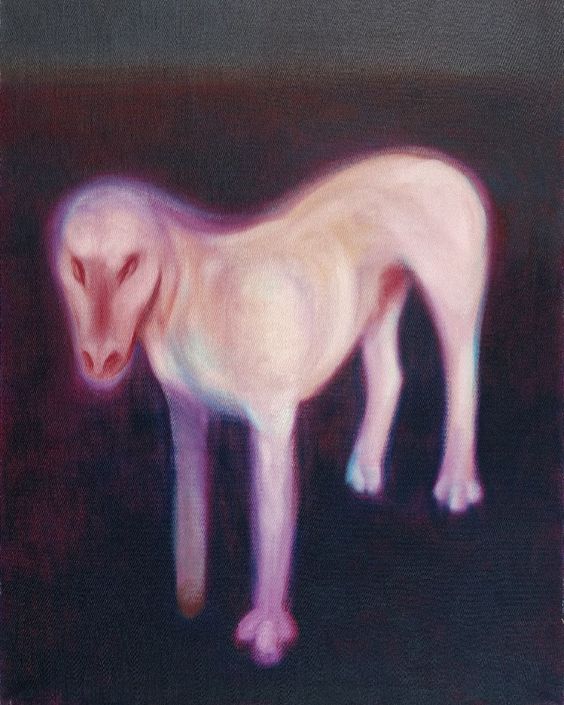
Miriam Cahn, Mich Betrachtend 2012
In this painting we see an animal-like figure. Frontally placed to the spectator. The figure distinguishes itself by standing in an atmospheric aura of grey-tones. The figure is painted with pink outlining through which it almost seems to glow. This glow causes the figure to have transcendental aspect to it. Through the undefined brushstrokes it is unclear what kind of ‘’animal’’ this is.
Cahn painted a lot of semi-ambiguous figures this way. Undefined and radiant. Figures just like this one with a confronting, enigmatic expression. Frontally faced to the spectator. Cahn’s paintings and drawings incorporate topics like feminism and female rituals. Featuring shocking representations of sexual organs representing a fragility and fertility and giving enhancing her figures with a sense of inner life. The paintings also depict a sort of violence, an indication of provocative danger.
The transcendence and supernaturality of this figure also gives it a very dream-like effect. As if you could encounter this figure in a nightmare. For me, the mysteriousness of the figure that seems like its calling out to you and seems to know more about you then you do about it, is what really attracts me in Cahn’s work.
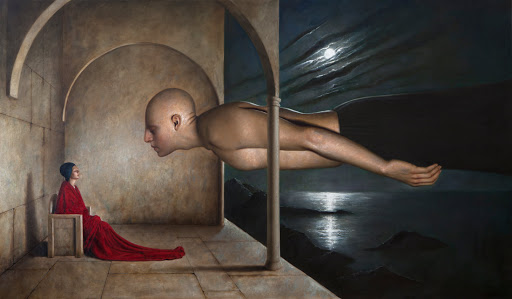
Alessandro Sicioldr, La Visita 2018
This painting depicts two figures depicted in a symbolistic dream-like dimension. One figure, dressed in a red garment sitting in an arched hallway of some sort. The hallway divides itself with classical pillars from what seems like an undefined sea view background at night. A big bald figure breaks the division between the two realms. It seems to float from out of nowhere looking intensively at the figure in the red garment.
Inspiration is drawn from surrealism, the irrationality and the exploration of the human psyche. Use of colors, light and the detailing are clearly drawn from Mannerism and Flemish painters. The painting seems to depict a subconscious realm of memories and thoughts.
The painting seems full of enigmas and we cannot properly define in words that what is depicted on the canvas.
The exploration of the human psyche depicted through these vision-like images is what I find very intriguing about Sicioldr’s work. It makes me think of the undefinable places I’ve visited in subconscious dreams and fantasies. And the not being able to describe what it is about and the use of surrealism and symbolism in a very skilled manner.
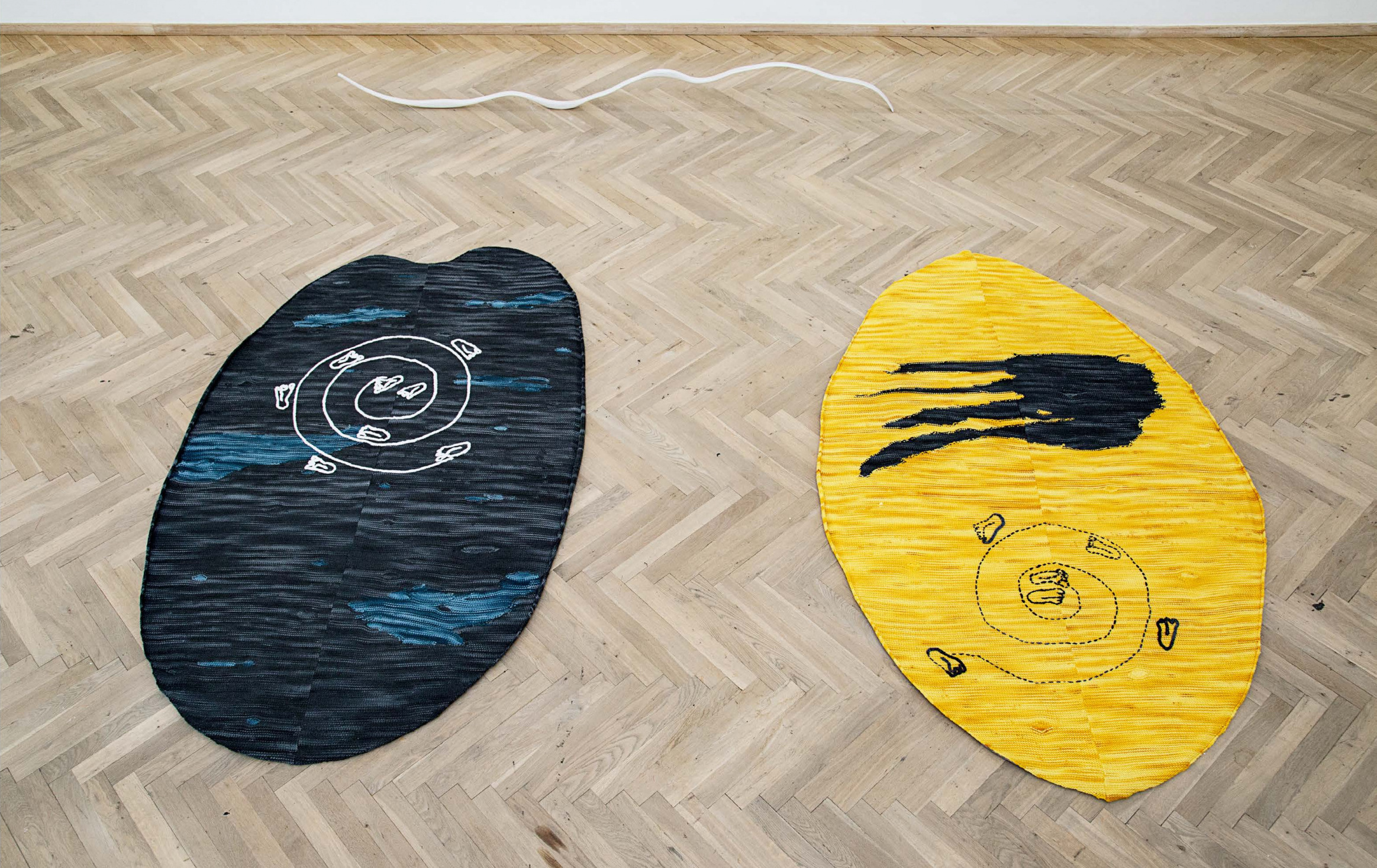
Jennifer Tee, Crystalline floor pieces 2013-ongoing
Jennifer Tee’s works consists of mainly sculpture, installation, performance, with an underlying wide-ranging frame of references. Tee’s main interest is in the in-between state of what she calls the soul in limbo. The soul in limbo is restless and alive, and caught in an unnamed place, a conceptual, mental, psychological, and physical space, on the border between the here and the possible. She also researches contemporary life, with its narratives in cross-cultural identities (she herself is half British and half Indonesian), its instability and complexity, and the loss of identity, language, and connection with original cultures. In addition, Tee explores various forms of utopian concepts of life and creating a new and soulful world. With her work, she encourages the contemplation of life’s fragile connections, evoking spiritual realms with material experimentation.
These two woven floor pieces are geometrical shapes derived from crystalline forms and structures. The dark blue and yellow colored floor pieces are knit with a hand-dyed wool and hover between sculpture and stage, their arrangement forming both a negative and positive space, simultaneously taking up the room’s volume and cutting into it. Tee is interested in evoking spiritual realms with materialistic translations, and the floor pieces create an enclosing space for the mind and body to connect.
Jennifer Tee’s installations are a big inspiration to me. Seeing she takes stories into another context. And embraces spirituality and spaces that can’t be seen. I think the Soul in Limbo links very well to my Inbetweener archetype. It is floating in between realms and doesn’t fully connect to one specific subject. I relate this work in particular to the installation subject I’m currently occupied with in my own practice. But more on that later.
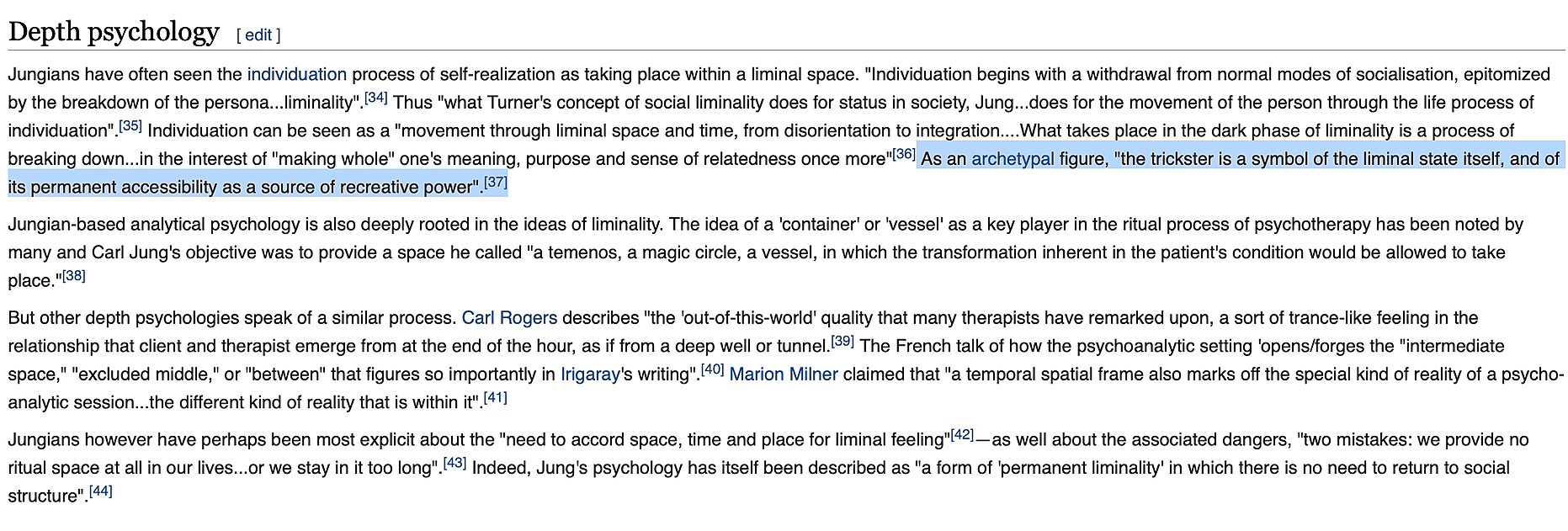
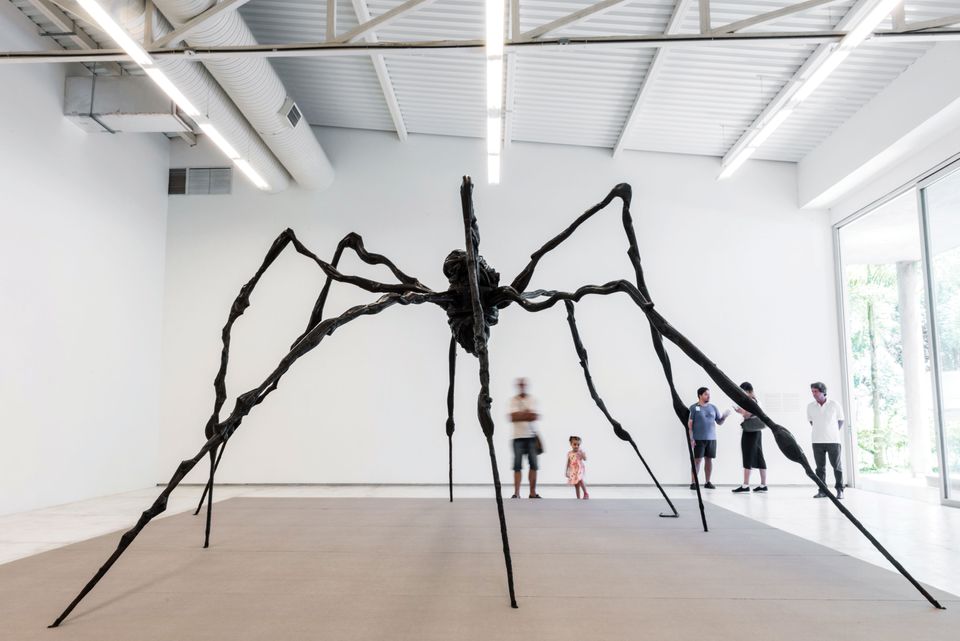
Louise Bourgeouis, Spider 1996
-Trauma
-Childhood memories
-Personal experiences
-Subconsciousness
Nora Turato, Explained away 2019
Explained Away is an exhibition containing an installation filled with quotes appropriated from the media, which addresses the viewers consumerism in an ironic way. Combined with a performance in which Turato is complaining in spoken word. The ever-growing scripts uses powerful narratives from text hysteria fragments circulating online, gathered from advertisements, social media and everyday life.
Turato defines language as the foundation of her work, from which she creates artworks in various media. Her performances confront the audience with a transformed reality, the language she uses is the language we use in our everyday life. It is as if, while she is talking, she is processing and negotiating our relationship to consumer goods, political, social and cultural views.
I think a confrontational performance like this is very empowering. It makes you aware of you as the consumer. And where you stand in certain social roles or political views. In my opinion Turato creates a strong narrative with her language and the way she uses
Consumerism of art and how I consume art:
To me art always needs to evoke a feeling in me to grab my attention. With this work i related in it in a way. The word vomit of the internet and daily life swirling over you. And with this rush of information not knowing how to selectively separate what you want to take in and what is unnecessary information.
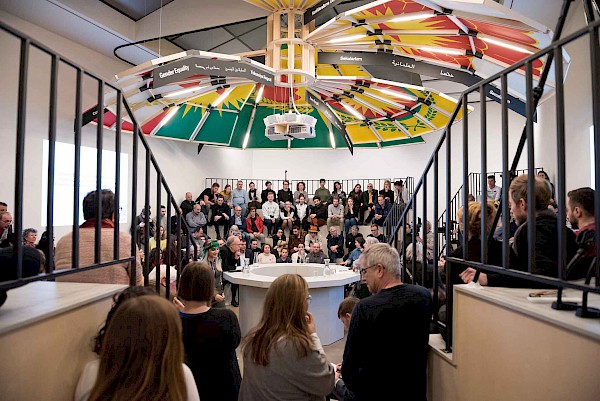
Jonas Staal, Museum as Parlement 2018-ungoing
In the war against Assad, the dictator of Syria, the Kurds conquered the North of Syria. Jonas Staal saw this as an opportunity to build a local parliament. Meant to give the Kurds a space to work on a new democracy. Jonas Staal saw the Kurds as freedom fighters, for women’s rights, against the dictature and against Assad. Inspired by a ‘’stateless democracy’’. A copy of this parliament has been built in the Van Abbe-museum. The Kurds have also been here.
The installation is a circle formed parliament building. Based on local self-governance, gender equality and communal economy. Its circular shape embodies the ideal collective, decentralized democratic representation. On the dome shaped ceiling the ‘’key values’’ of stateless democracy such as ‘’gender equality’’ and ‘’social ecology’’ are written. And its rooftop consists of a confederation of fragments of flags that belong to the local organizations of the Rojava region.
The Museum as Parliament was meant to introduce the ideals of the Rojava revolution to a wider public and to build alliances with emancipatory political organizations, platforms, activist groups and cultural workers from Kurdistan to the Netherlands.
I think the text writings on the ceiling don’t add up with the conservative culture of the Kurds. I think Jonas Staal has formed the Kurds’ ideals and ideas to a very western perspective. By adding these texts Jonas Staal is claiming these are the center values of what their democracy is about. The Kurds are invested in their relations with the western media, and I think that is why they accepted to work with an artist like Jonas Staal. In the long term it can be good for their image to build a good relationship, they don’t care if the west glorifies them wrongfully.
Realms, Fantasies, spiritual connections and inspirations
Relation to personal subjects used in art
Background Image by: Astrid Terrazas
Astrid Terrazas, Worlds (paintings)
Astrid Terrazas is a Mexican-American artist living in Ridgewood, Queens. Terrazas re-writes worlds; her narratives reflect ancestral folklore, lived experiences, and unearthly transfigurations.
They are stories that push personal and communal trauma towards tangible healing. Terrazas uses recurring motifs as artifacts of protection, meant to cast a safety spell upon anyone who encounters them.
Her work takes the form of painting, illustrated ceramic vessels, and mixed media sculpture.
She is one of my biggest inspirations at the moment. As she gathers and build her stories in the same image you begin to wonder what is being told. I can empathize with these works as Terrazas also uses her works as a vessel to carry messages and to give her traumas a space to rest.
One of my inspirations this semester was Heidegger's Being and time. And more so the Being in Time. As i interpreted it (I'm relating to my own interpretation because Heidegger is very hard to understand).I use myself in different time-frames in my own works. I see the stories that played off in my childhood and that still live around me as a sort of liminal world. A world that is constantly around you. And by acknowledging it you're able to step into.
Another inspiration for me was the famous Descartes sentence ''i think therefore i am''. As i use stories to give my trauma a space to rest. I tend to dissociate a lot because of PTSD and so i found this phrase quite funny. ''I think too much therefore i am not quite entirely''. In my work i see dissociating as a good thing. Stepping out of the reality and into a new one. And that is what i like about the works of, for example, Terrazas and Afra Eisma.
I will elaborate more on relations in art to subjects like these in the discussed works underneath.
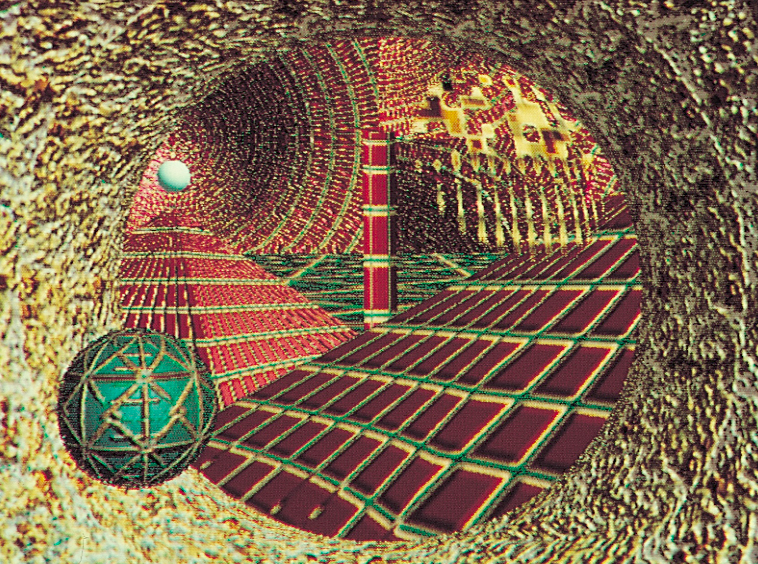
David Em, Nora 1979
Digital portal
Liminal/made up world, created in another medium
Endlessness of digitalization
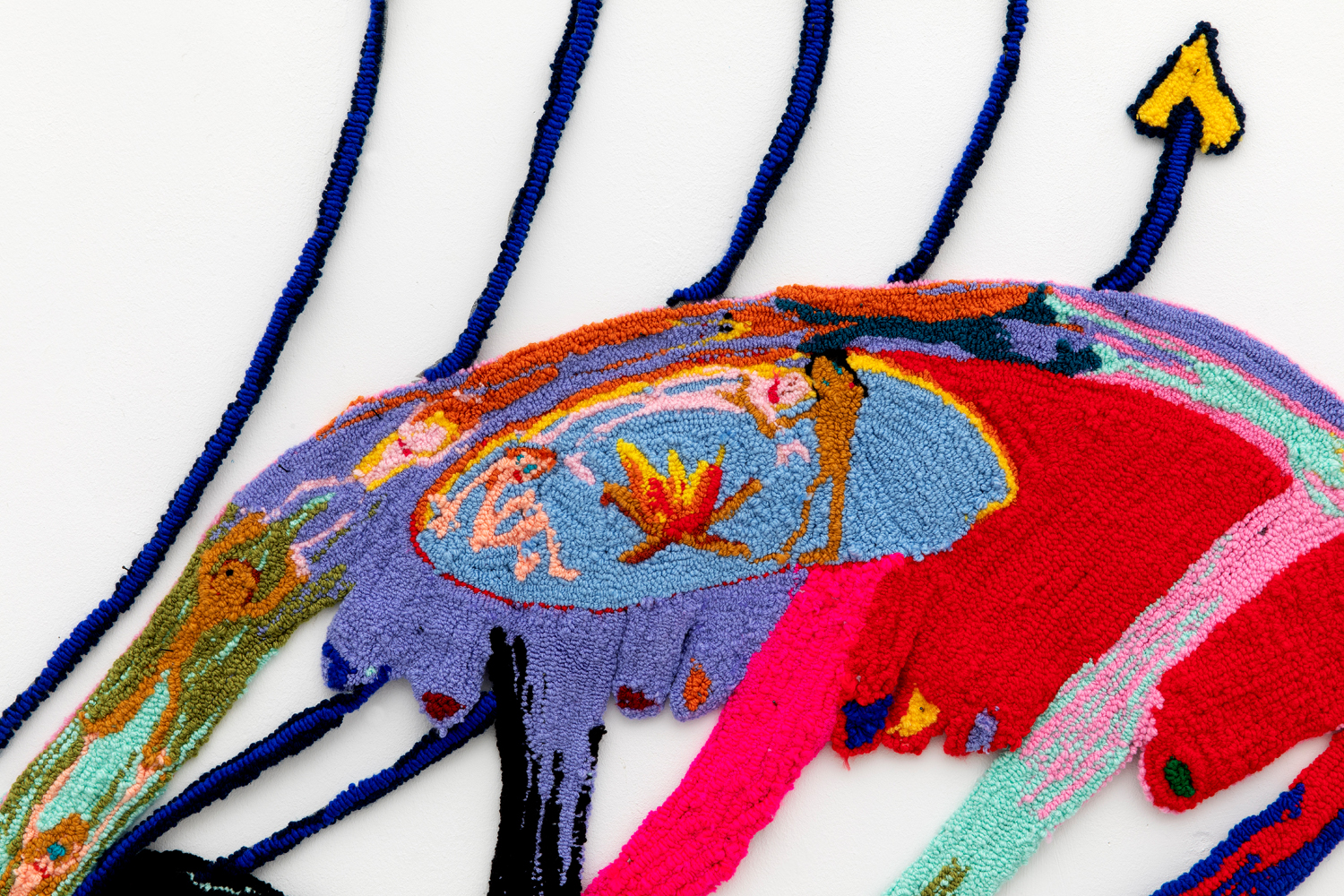
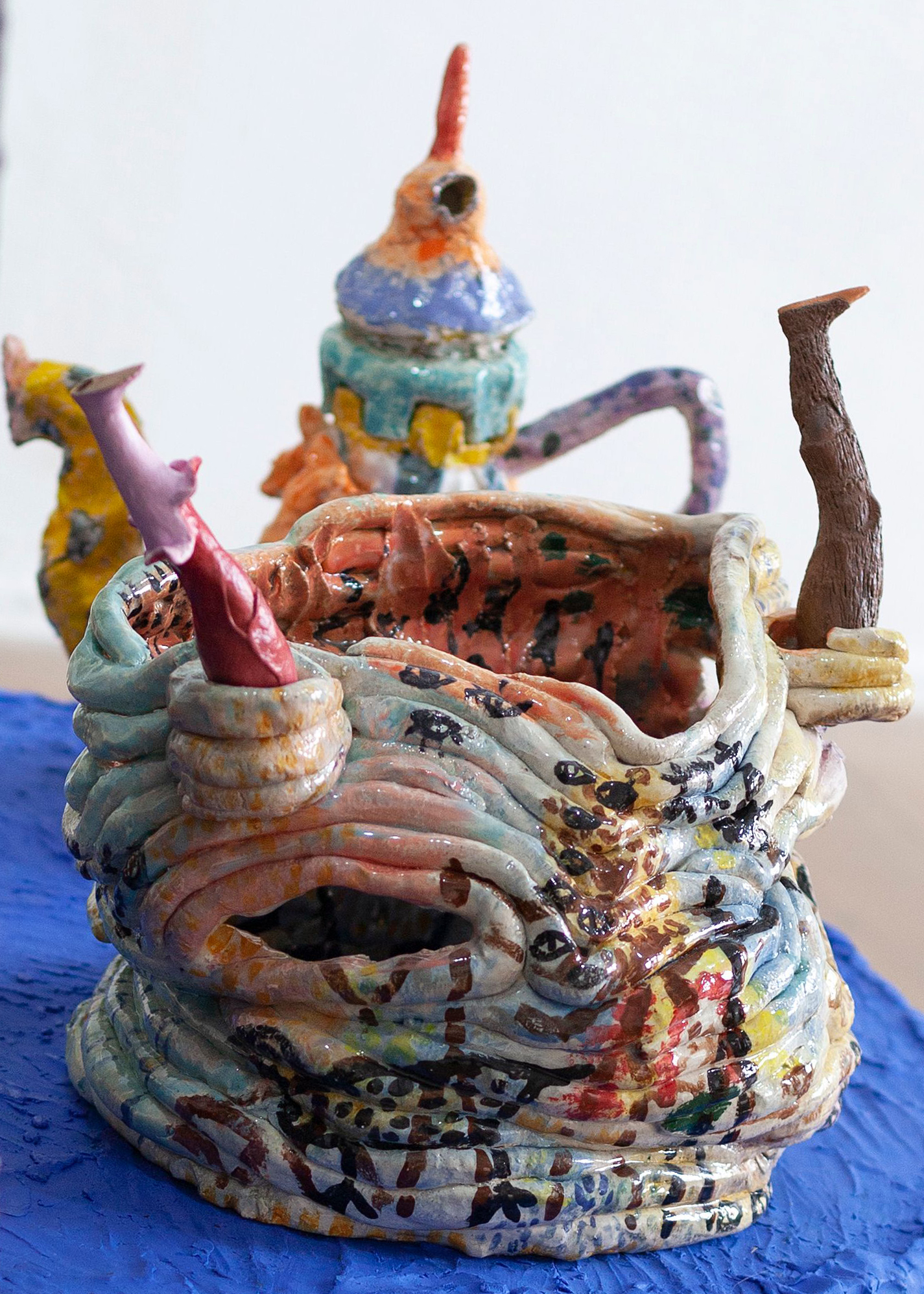
Afra Eisma
Afra Eisma’s work can be described as both autobiographical and energetic. In the realities which she constructs, stories are told through color and play and imagination. Using sculpture, textiles and ceramics Eisma shows an enormous lust to give life to the worlds she creates: stories must be shared and the energy is being transferred to an audience. Within entering the overload of objects, our personal game starts. While sticking together the pieces of this visual puzzle, the story reveals itself. In a world that is intoxicated with alienation, exclusion and fear, opening up yourself is extremely important, Eisma states. Eisma's work is very personal and she uses it to give her own trauma a place. What i like about Afra Eisma's work is that she is okay with telling this story, giving it a world to live in. But not needing the audience know all of it. She is very open to her audience relating to her work by their own experiences. All she does is hand the pieces of stories. The rest is up to the imagination of the audience. She also talked about this very openly in a podcast episode of Mister Motley's Kunst is Lang. Which i will link below. I didn't want to chose only one work of her. But rather giving an impression of the atmosphere she creates by multiple pictures.
Mother earth's plantasia by Mort Garson 1976
This beautiful enchanting album was created by Mort Garson in the 70's. The music was composed specifically for plants to listen to. It was also only available for people who brought a plant to the store from the Mother Earth plant store in Los Angeles.As a result, the album failed to attain widespread popularity around the time of its release.
I was actually listening to this album while writing this assignment and i thought to myself; i can already imagine this music playing when you walk into the world i create and make my stories in. The way it's composed creates a sort of feeling of freedom and euphoria within me.
Click here to listen and experience!
Kunst is Lang-Afra Eisma click here
Political and social relations, contradictions and viewpoints
I'm thinking of ending things, Charlie Kaufman 2020
Just as with Heidegger, Charlie Kaufman the director of this movie questions the way time moves. But he places the characters in the movie as solid beings while time moves around them. Instead of beings moving in time. You follow the story of a young girl, who's name is not revealed in the first part of the movie. She goes to visit her boyfriends parents for the first time. But the events happening during this ''time period'' seem to take rather strange turns. After watching the movie multiple times (which i did), little changes and symbolistic meanings become more noticeable. The story becomes a loop and it doesn't seem to know where it starts and where it ends. In the movie itself the girl even states: "People Like To Think Of Themselves As Points Moving Through Time, But I Think It's Probably The Opposite." This movie was very intriguing to me. And i don't want to explain it too much. I think you should just go watch it :).
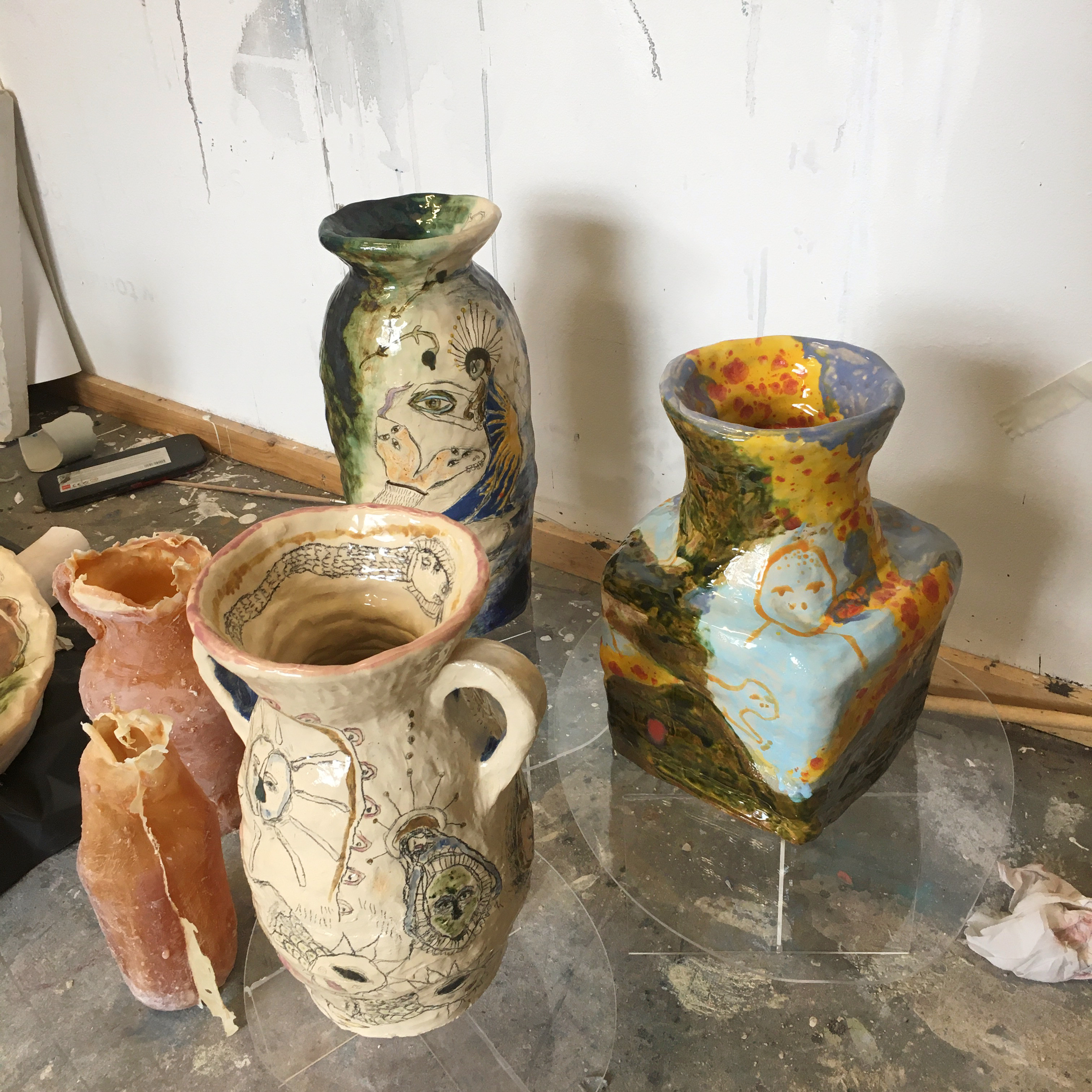
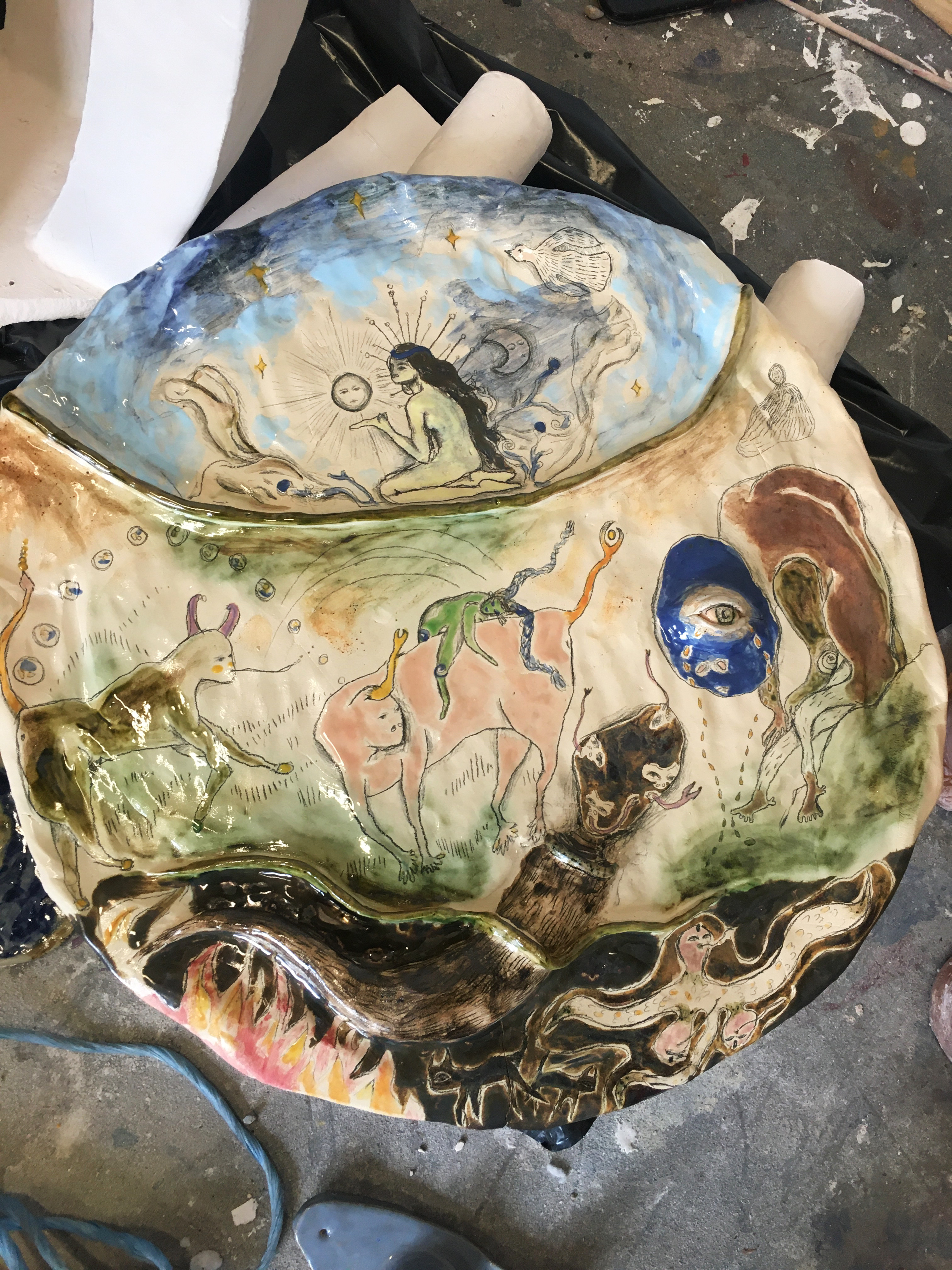
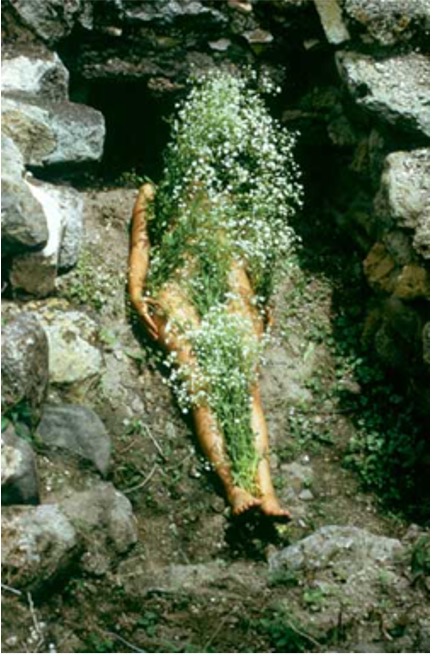
Ana Mendieta, Flowers on body 1973
-Humans relation to nature
Final words
In the end, I think my research question wasn't all that relevant. I also didn't gravitate towards answering that question at all. Instead i think asked questions that related more to myself and how i could develop personally in my practice. By putting artists and inspirations in a larger context i could see how they all started to connect to each other. And in the end, the making of my own archetype gave me more freedom. I didn't feel limited in what i could and couldn't include because it ''wouldn't fit with my archetype''. But of course it fits with my archetype. Because it is me. It is all linked to me. Doesn't matter if it makes sense or not.
I hope you enjoyed reading about my viewpoints and inspirations. And i hope i will always keep adding to this list.
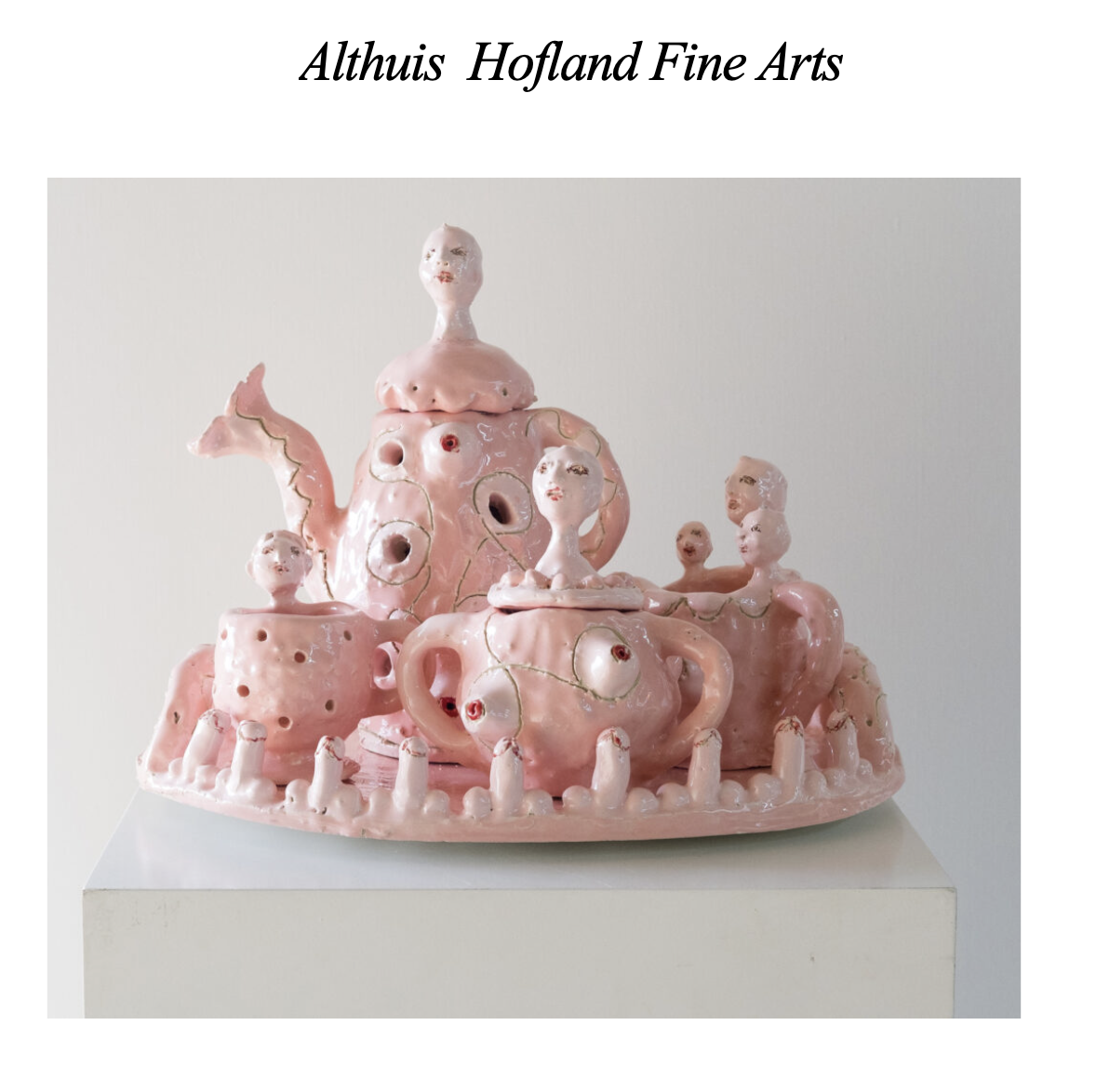
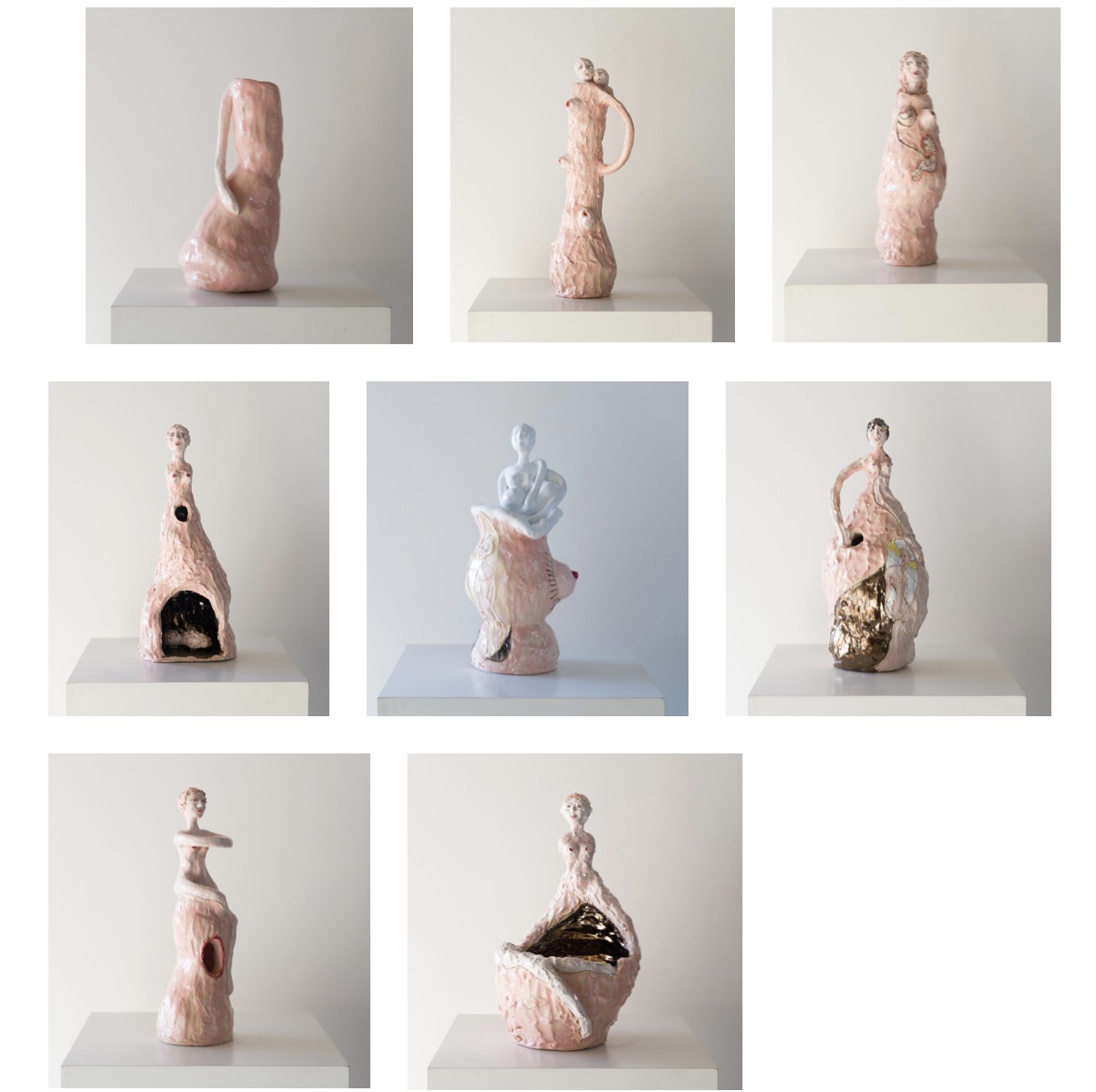
Marliz Frencken, ‘How we met through Instagram’ Two person exhibition with David Brian Smith 2021
The past few months i discovered that art galleries didn't really care about if you make a reservation or not. So I started visiting a lot of galleries. Mostly in Amsterdam. Just to get back in to what is happening in contemporary art right now. I was at Althuis Hofland the other day and saw this work by Marliz Frencken. Of course i was immediately intrigued by the ceramics. I saw some similarities with my own work and some works i discussed above, while reading the press release. Which you can read in the link down below.
Click here for press release
Me!
Sarah, 1999-ongoing
This past semester I think I've really found my passion. Which is ceramics. I could say my work is very autobiographical and i have a need to tell (pieces of) stories in the things i make. This in combination with ceramics was a match made in heaven. I dove into the kraft of ceramics and everything there is to learn on it. I've spent almost every day of the past 3 months in the Ceramics workshop at school. And i can definitely say I've never been so motivated for anything in my life.
Artists like Astrid Terrazas and Afra Eisma have been big inspirations to me. And i think you can already really see that back in the works (photo on the left). I hope in the next years i can expand my work more using the medium of ceramics. My goal is to eventually make super big installations where i can let my ceramics (and other works) tell the story that they need to.
The subject of these works revolve around the nostalgia you feel toward your years growing up as a child. And the wild fantasies you could create and bring to life as a child. I took inspiration from folklore stories, myths, religion, classical elements and also my own heritage as being part Caribbean and Chinese as well as Dutch. As i feel these all relate to each other and my upbringing.
Hannah Black, The fall of communism
Click here